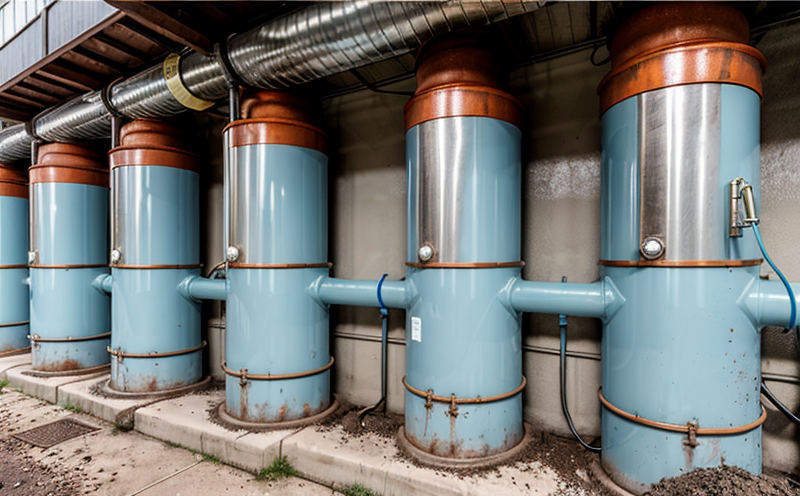ASTM G222 Corrosion Depth Measurement Test in Water
The ASTM G222 standard is a critical tool used to assess the depth of localized corrosion on metallic materials immersed in water. This test is particularly useful for evaluating the performance and durability of materials that are exposed to aggressive corrosive environments, such as those found in water distribution systems, cooling towers, and industrial processes involving water.
Corrosion is a significant challenge in many industries, leading to increased maintenance costs, reduced material lifespan, and potential safety hazards. ASTM G222 provides a standardized method for quantifying the extent of localized corrosion, which can help in making informed decisions about material selection, design optimization, and maintenance strategies.
The test involves immersing samples of metallic materials in water under controlled conditions to simulate real-world exposure. The samples are then inspected using microscopic techniques to measure the depth of any pitting or other forms of localized corrosion. This allows for precise quantification of the corrosion damage, which is essential for understanding the long-term performance and reliability of materials.
The results from ASTM G222 can be used in various ways:
- To compare different materials and identify those with superior resistance to localized corrosion.
- To assess the effectiveness of protective coatings or treatments applied to metallic surfaces.
- To inform design changes that could enhance material performance under corrosive conditions.
- To guide maintenance schedules by identifying areas where corrosion is most likely to occur.
The ASTM G222 test can be particularly useful in sectors such as water treatment, pharmaceuticals, and power generation, where the integrity of metallic components is critical. By using this standard, organizations can ensure that their materials are capable of withstanding harsh corrosive environments without compromising safety or performance.
| Applied Standards |
|---|
| ASTM G222 - Standard Practice for Measuring the Depth and Location of Localized Corrosion in Metallic Materials Immersed in Water |
Why It Matters
The importance of ASTM G222 cannot be overstated, especially given the critical role that materials play in water systems. Proper corrosion control is essential for maintaining system integrity and ensuring public safety. Water systems are subject to a variety of corrosive agents, including dissolved oxygen, carbon dioxide, chlorides, and other compounds present in water.
Localized corrosion, such as pitting or crevice corrosion, can lead to sudden failures if not properly managed. These failures can result in leaks, structural damage, and even catastrophic failures, which can have severe consequences for both the environment and public health. By using ASTM G222, organizations can proactively manage these risks by identifying and addressing areas of localized corrosion before they escalate into larger issues.
The test also plays a crucial role in compliance with regulatory requirements. Many industries are subject to stringent regulations regarding water quality and material durability. Using ASTM G222 ensures that organizations meet these standards, thereby minimizing the risk of non-compliance penalties and enhancing their reputation for reliability.
In summary, ASTM G222 is vital for maintaining the integrity of materials in water systems, ensuring public safety, and meeting regulatory requirements. Its use helps to identify and mitigate risks associated with localized corrosion, ultimately leading to more reliable and sustainable infrastructure.
Applied Standards
The ASTM G222 standard is a recognized benchmark for measuring the depth of localized corrosion in metallic materials immersed in water. This test is applicable across various industries, including water treatment, pharmaceuticals, power generation, and environmental engineering, where materials are exposed to corrosive environments.
| Applied Standards |
|---|
| ASTM G222 - Standard Practice for Measuring the Depth and Location of Localized Corrosion in Metallic Materials Immersed in Water |
The test involves immersing samples of metallic materials in water under controlled conditions to simulate real-world exposure. The samples are then inspected using microscopic techniques to measure the depth of any pitting or other forms of localized corrosion. This allows for precise quantification of the corrosion damage, which is essential for understanding the long-term performance and reliability of materials.
The ASTM G222 test can be particularly useful in sectors such as water treatment, pharmaceuticals, and power generation, where the integrity of metallic components is critical. By using this standard, organizations can ensure that their materials are capable of withstanding harsh corrosive environments without compromising safety or performance.
Customer Impact and Satisfaction
- Enhanced reliability of materials in corrosive environments.
- Proactive identification and mitigation of corrosion risks.
- Compliance with regulatory requirements for water quality and material durability.
- Improved decision-making regarding material selection, design optimization, and maintenance strategies.
- Reduction in the risk of sudden failures and associated costs.
- Enhanced reputation for reliability and safety within the industry.
The use of ASTM G222 has a direct impact on customer satisfaction by ensuring that materials are capable of withstanding harsh corrosive environments without compromising safety or performance. This standard provides peace of mind to quality managers, compliance officers, R&D engineers, and procurement professionals who rely on it for critical decisions.





